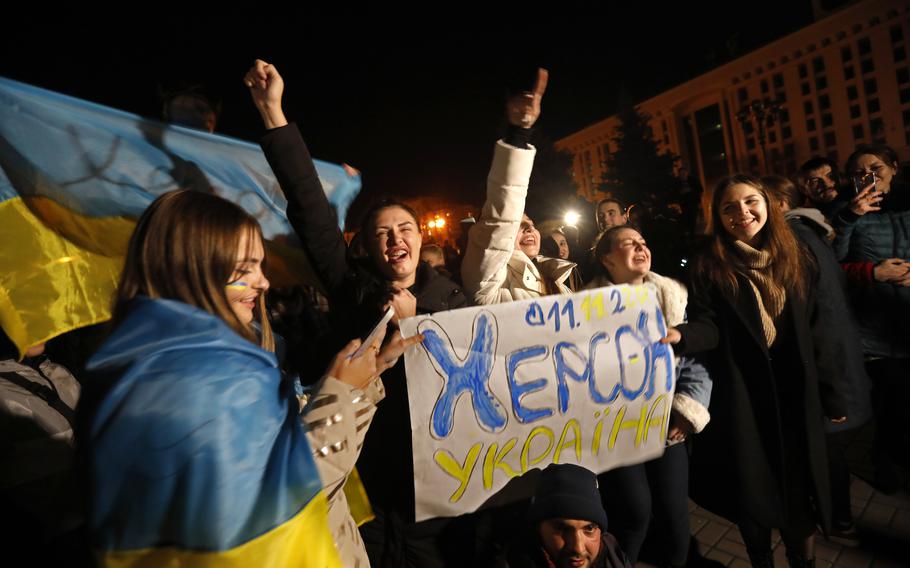
Ukrainians gather in Kyiv’s Independence Square to celebrate Russian troops’ withdrawal from Kherson. (Carolyn Cole, Los Angeles Times/TNS)
(Tribune News Service) — The day the Ukrainian Parliament declared independence on Aug. 24, 1991, I witnessed the historical moment from the gallery with my wife and a group of Western expatriates. Below us, amid rapturous applause, a huge Ukrainian flag was carried into the hall on the shoulders of many of Ukraine’s founding fathers. In a poignant instance of historical revenge, they draped the flag on the dais under a large statute of Vladimir Lenin and bellowed out “Chervona Kalyna,” the song that has since become the unofficial Ukrainian anthem of resistance during the country’s current war with Russia.
Up in the balcony, marveling at what was unfurling, we hugged one another and shed tears of joy. I thought of my parents, who had fled Ukraine and the tyranny of communism during World War II and settled in the Detroit area. We were experiencing a miracle about which they could have only dreamed.
But unlike Ukraine’s Warsaw Pact neighbors, which began the painful transition from communism to capitalism and became nascent — though often struggling — democracies seeking to join the European family, Ukraine faced a far more difficult task. As an adviser working in Ukraine’s new parliament, I had a front-row seat, and it was not a pretty sight.
History had sown deep divisions among Ukrainians: those who spoke Russian versus those who spoke Ukrainian; Catholic versus Orthodox; and descendants of Austro-Hungarian and Polish rule in the West versus those who had for decades endured Russian hegemony and Soviet terror. While the country was undertaking arduous economic reforms, it also had to resolve linguistic, religious and regional tensions and put in place the basic structures of a functioning state.
Moreover, oligarchs, who showed great ingenuity in stealing state assets, seized control of the economy, undermining effective reform and development. Post-Soviet apparatchiks under President Leonid Kuchma (1994-2005) dominated the corruption-ridden government. Freedom of the press was curtailed. In 2000, the decapitation of the crusading journalist Georgiy Gongadze horrified the nation.
Consequently, the early post-independence months of euphoria quickly dissipated.
And then, in late 2004, Ukraine took the next historic steps on its journey of building a nation, first with the Orange Revolution, which rejected a Soviet-style rigged election, and then with the Maidan Revolution of 2014, which toppled the pro-Russian government that was blocking efforts to put Ukraine on a course toward Europe.
Despite the progress, opinion polls and voting patterns still reflected deep divisions along regional and generational lines, as well as on pro-European or pro-Russian orientation. And then, in March 2014, Vladimir Putin annexed Crimea, and Russian proxies started a war in Ukraine’s eastern provinces. One year ago, Putin launched an unprovoked, full-scale invasion.
As Putin continues his systematic destruction of the country, especially the largely Russian-speaking cities such as Kharkiv, Chernihiv, Mariupol and others, the linguistic, religious and cultural differences that used to divide Ukraine have largely disappeared. Ukrainians are now being brought together by the common cause of defeating their invader. Moreover, Putin’s war has inadvertently put Ukraine on the map, turning President Volodymyr Zelenskyy into a Churchillian wartime leader.
The irony is not lost. Josef Stalin, who perpetrated the Holodomor, the Great Famine of 1932-33 that killed millions of Ukrainians, shaped the modern-day borders of Ukraine through a series of territorial consolidation. And now Putin, a denier of the very existence of the Ukrainian people and language, has arguably done more than any figure in history to create a unified Ukrainian nation and flush out the fifth column of pro-Russian collaborators and sympathizers who have hampered the country’s alignment with Europe.
Completing the country’s final journey to nationhood requires two steps.
First, before the invasion, corruption still plagued Ukrainian society. The oligarchs held sway over the economy and the country’s judicial system was in dire need of reform. As a result of the war, Ukrainian society will not tolerate a return to the past, nor will its Western partners. However, the corrupt vultures will likely rise again and try to feast off the spoils.
It is not too early for Ukraine’s allies to begin planning a postwar policy that will aggressively leverage the billions of dollars in reconstruction aid to mandate the rooting out of pervasive corruption, an overhaul of the legal system and the elimination of oligarchy. Without these changes, reconstruction will fail.
Second, Ukraine needs to have a realistic prospect of joining the European Union on an accelerated timeline. This step will incentivize the needed reforms and help shape a nation that not only aspires to, but also puts into practice, Western values and norms.
In 1991, swept up in the heady euphoria and idealism of the moment, I naively assumed that Ukraine’s time as a country had come. It has taken another 32 years for the country to be on the cusp of finally reaching that goal.
In the future, as the people of Ukraine reorganize, rebuild and reform their nation, they will not only need continued Western military support but also a real chance to join the EU — along with some tough love to ensure that they take the final, crucial steps needed to realize their dream.
John Hewko is CEO of the Evanston, Ill.-based Rotary International. He advised the Ukrainian Parliament in the early 1990s and assisted a working group that prepared the initial draft of Ukraine’s post-Soviet constitution.
©2023 Chicago Tribune.
Visit at chicagotribune.com.
Distributed by Tribune Content Agency, LLC.